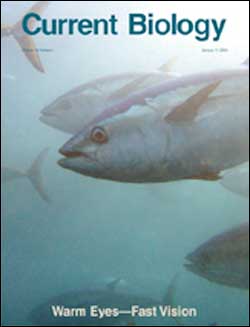Predator fish heat their eyes to track prey

Large and powerful predators such as swordfishes, tunas, and many sharks are unique among fishes in that they possess physiological mechanisms that warm their eyes. A new investigation reported this week sheds important light on the purpose of warming the eyes and the advantage that “warm eyes” confer on ocean predators.
Swordfishes, which hunt in water as cold as 3°C (about 37°F), can maintain their brain and eye temperatures 10°C–15°C (18°F –27°F) above ambient temperatures by using a specially adapted heating organ in muscle next to their eyes. The biological significance of this has been a mystery. Now, however, innovative research has shown that warm eyes allow swordfishes to process visual information more than 10 times more quickly than eyes cooled to the temperatures of deep-water environments.
Ship-board experiments by Kerstin Fritsches of the University of Queensland, Richard Brill of the National Marine Fisheries Service, and Eric Warrant of the University of Lund focused on electroretinogram recordings of freshly caught swordfishes. These established that higher eye temperatures maintain the speed of the retina’s response to stimuli. Using temperatures and light intensities aligned with swordfishes’ dive profiles, the team showed that by heating their eyes, swordfishes retain the ability to spot quickly moving objects, allowing them to intercept rapid and elusive prey.
These findings offer a fascinating view into how an evolutionary “arms race” has led to a sensory specialization that gives a predator a significant edge over its prey.
Media Contact
All latest news from the category: Life Sciences and Chemistry
Articles and reports from the Life Sciences and chemistry area deal with applied and basic research into modern biology, chemistry and human medicine.
Valuable information can be found on a range of life sciences fields including bacteriology, biochemistry, bionics, bioinformatics, biophysics, biotechnology, genetics, geobotany, human biology, marine biology, microbiology, molecular biology, cellular biology, zoology, bioinorganic chemistry, microchemistry and environmental chemistry.
Newest articles

Pinpointing hydrogen isotopes in titanium hydride nanofilms
Although it is the smallest and lightest atom, hydrogen can have a big impact by infiltrating other materials and affecting their properties, such as superconductivity and metal-insulator-transitions. Now, researchers from…

A new way of entangling light and sound
For a wide variety of emerging quantum technologies, such as secure quantum communications and quantum computing, quantum entanglement is a prerequisite. Scientists at the Max-Planck-Institute for the Science of Light…

Telescope for NASA’s Roman Mission complete, delivered to Goddard
NASA’s Nancy Grace Roman Space Telescope is one giant step closer to unlocking the mysteries of the universe. The mission has now received its final major delivery: the Optical Telescope…



